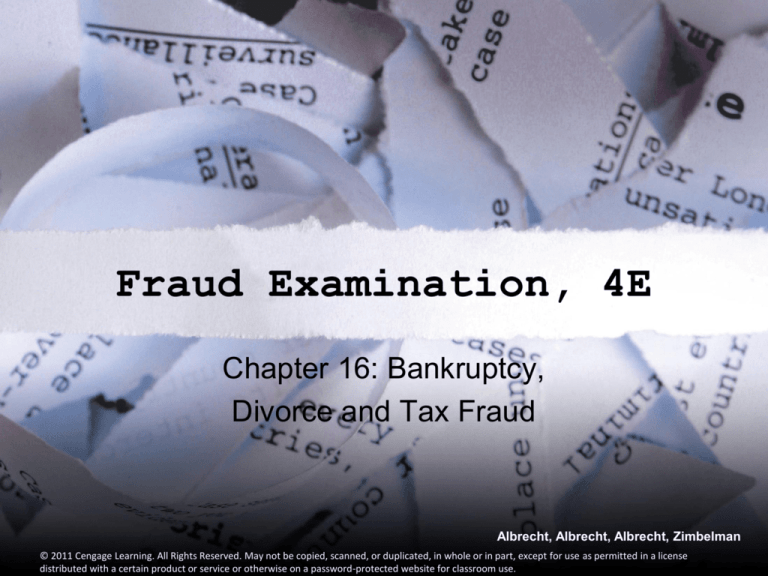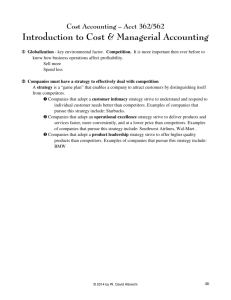
Fraud Examination, 4E
Chapter 16: Bankruptcy,
Divorce and Tax Fraud
Albrecht, Albrecht, Albrecht, Zimbelman
© 2011 Cengage Learning. All Rights Reserved. May not be copied, scanned, or duplicated, in whole or in part, except for use as permitted in a license
distributed with a certain product or service or otherwise on a password-protected website for classroom use.
Learning Objectives
Understand how perpetrators fraudulently conceal
and transfer assets and income in bankruptcies
and divorces.
Define tax fraud and be familiar with common tax
fraud schemes.
Understand how money laundering is used to
commit fraud.
Albrecht, Albrecht, Albrecht, Zimbelman
© 2011 Cengage Learning. All Rights Reserved. May not be copied, scanned, or duplicated, in whole or in part, except for use as permitted in a license
Overview of Tax, Divorce and
Bankruptcy Frauds
Bankruptcy fraud is a growing problem in the
United States. Bankruptcy is the legal process
that allows a debtor to work out an orderly plan to
either settle debts or liquidate assets and
distribute them to creditors.
The reason that fraud is so common in
bankruptcies, divorces, and tax payments is
because, in all three situations, assets are being
taken away from someone or some organization
and given to someone else.
Albrecht, Albrecht, Albrecht, Zimbelman
© 2011 Cengage Learning. All Rights Reserved. May not be copied, scanned, or duplicated, in whole or in part, except for use as permitted in a license
Bankruptcy and Divorce Fraud
Several different types of bankruptcy and divorce
frauds are noteworthy:
Bankruptcy or Divorce Resulting from Fraud
Too few assets remaining to pay creditor and investor claims, an entity will
generally file bankruptcy. Similarly, when one marriage partner discovers that
his or her spouse has committed fraud, he or she often seeks divorce to
salvage a reputation or because of a lack of trust in the partner.
Bankruptcy and Divorce used to perpetuate Fraud
Some debtors use the “automatic stay” period to perpetuate fraud
Bankruptcy and Divorce used to conceal Fraud
Generally results in the books and records of the debtor or marital partner being
destroyed, inaccurate, or hard to locate.
Albrecht, Albrecht, Albrecht, Zimbelman
© 2011 Cengage Learning. All Rights Reserved. May not be copied, scanned, or duplicated, in whole or in part, except for use as permitted in a license
Tax Fraud
Tax fraud can be committed against any governmental or
other organization that collects taxes, including the federal
government, state governments, local governments or
other taxing authorities.
Common Tax Fraud Schemes
Deliberately underreporting or omitting income
Overstating tax deductions
Keeping two sets of books
Making false entries in books and records
Albrecht, Albrecht, Albrecht, Zimbelman
© 2011 Cengage Learning. All Rights Reserved. May not be copied, scanned, or duplicated, in whole or in part, except for use as permitted in a license
Tax Fraud
Claiming personal
expenses as business
expenses
Claiming false deductions
Hiding or transferring
assets or income
Illegal money laundering
schemes
Albrecht, Albrecht, Albrecht, Zimbelman
© 2011 Cengage Learning. All Rights Reserved. May not be copied, scanned, or duplicated, in whole or in part, except for use as permitted in a license
Tax Laws for Fraud Perpetrators
Albrecht, Albrecht, Albrecht, Zimbelman
© 2011 Cengage Learning. All Rights Reserved. May not be copied, scanned, or duplicated, in whole or in part, except for use as permitted in a license
IRS CRIMINAL INVESTIGATIONS
ACTIVITY, 2004-2006
Albrecht, Albrecht, Albrecht, Zimbelman
© 2011 Cengage Learning. All Rights Reserved. May not be copied, scanned, or duplicated, in whole or in part, except for use as permitted in a license
Divorce Fraud
Most divorce fraud litigation results from two
allegations:
The plaintiff spouse claims that the defendant hid
assets so they would not have to be shared or taken
away
or
(2) The values assigned to assets were unrealistically
low, thus resulting in an unfair divorce settlement.
Albrecht, Albrecht, Albrecht, Zimbelman
© 2011 Cengage Learning. All Rights Reserved. May not be copied, scanned, or duplicated, in whole or in part, except for use as permitted in a license
Bankruptcy Fraud
The bankruptcy system, an arm of the U.S. District Court,
is a critical component of the U.S. government because of
the impact bankruptcy filings have on the national and
local economies.
Monies defrauded from a bankruptcy never reach the
pockets of deserving creditors and investors.
The loss of faith in the legal process (bankruptcy) by
creditors and investors can have a ripple effect in the
economy through the tightening of credit, the raising of
interest rates and subsequent economic reactions.
Albrecht, Albrecht, Albrecht, Zimbelman
© 2011 Cengage Learning. All Rights Reserved. May not be copied, scanned, or duplicated, in whole or in part, except for use as permitted in a license
The Bankruptcy Code
Title 11 of the U.S. Code is referred to as the
Bankruptcy Code.
The code provides for several types of bankruptcy.
Chapters 1,3, and 5 contain general provisions that apply to all
bankruptcies.
Chapters 7,11, and 13 apply to specific types of bankruptcy.
Albrecht, Albrecht, Albrecht, Zimbelman
© 2011 Cengage Learning. All Rights Reserved. May not be copied, scanned, or duplicated, in whole or in part, except for use as permitted in a license
Criminal Bankruptcy Statutes
Concealment of Assets, False Oaths and
Claims, and Bribery (18 USC 152)
It is a crime to…
Conceal property of a debtor’s estate from creditors
Make a false oath or account in a bankruptcy case
Give, offer, receive, or attempt to obtain money or
property, remuneration, compensation, reward,
advantage or promise thereof for acting or forbearing to
act in a bankruptcy case.
Albrecht, Albrecht, Albrecht, Zimbelman
© 2011 Cengage Learning. All Rights Reserved. May not be copied, scanned, or duplicated, in whole or in part, except for use as permitted in a license
Criminal Bankruptcy Statutes
Embezzlement Against the Debtor’s Estate (18
USC 153)
The statute makes it a crime for such persons to
“knowingly and fraudulently appropriate to [their] own
use, embezzle, spend, or transfer” any property, or to
hide or destroy any document, belonging to the debtor’s
estate.
Albrecht, Albrecht, Albrecht, Zimbelman
© 2011 Cengage Learning. All Rights Reserved. May not be copied, scanned, or duplicated, in whole or in part, except for use as permitted in a license
Criminal Bankruptcy Statutes
Adverse Interest and Conduct of Officers(18 USC 154);
it is a crime to knowingly:
Purchase, directly or indirectly, any property of the debtor’s estate
of which the person is an officer in a bankruptcy case
Refuse to permit a reasonable opportunity for the inspection by
parties in interest of the documents and accounts relating to the
affairs of the estate in the person’s charge when directed by the
court to do so.
Refuse to permit a reasonable opportunity for inspection by the
U.S. Trustee of the documents and accounts relating to the affairs
of the estate in the person’s charge.
Albrecht, Albrecht, Albrecht, Zimbelman
© 2011 Cengage Learning. All Rights Reserved. May not be copied, scanned, or duplicated, in whole or in part, except for use as permitted in a license
Criminal Bankruptcy Statutes
Bankruptcy Fraud
It is a crime to do any of the following to
execute or conceal a fraud scheme:
File a bankruptcy petition.
File a document in a bankruptcy proceeding.
Make a false or fraudulent representation, claim, or
promise with respect to a bankruptcy proceeding, either
before or after the bankruptcy petition is filed
Albrecht, Albrecht, Albrecht, Zimbelman
© 2011 Cengage Learning. All Rights Reserved. May not be copied, scanned, or duplicated, in whole or in part, except for use as permitted in a license
Civil Bankruptcy Statutes
Offenses Leading to
Revocation of Debt
Discharge (Section 1144
of the Bankruptcy Code)
For example, if a debtor
lied about (usually by
understating) the amount
of his or her assets in
order to get debts
forgiven, the forgiveness
or discharge of the debts
could be revoked.
Albrecht, Albrecht, Albrecht, Zimbelman
© 2011 Cengage Learning. All Rights Reserved. May not be copied, scanned, or duplicated, in whole or in part, except for use as permitted in a license
Civil Bankruptcy Statutes
Fraudulent Transfers (Section 548 of the
Bankruptcy Code)
A transfer made, or obligation incurred, within
one year before the bankruptcy petition’s
filing date that was:
Made with the actual intent to hinder, delay, or defraud
creditors
Made for less than reasonably equivalent value
Albrecht, Albrecht, Albrecht, Zimbelman
© 2011 Cengage Learning. All Rights Reserved. May not be copied, scanned, or duplicated, in whole or in part, except for use as permitted in a license
Participants in the
Bankruptcy Process
The parties involved in
the bankruptcy process:
Bankruptcy court
U.S. Trustee
Court-appointed or panel
trustee
Examiners
Debtors
Creditors
Adjusters (operations
or field agents)
Albrecht, Albrecht, Albrecht, Zimbelman
© 2011 Cengage Learning. All Rights Reserved. May not be copied, scanned, or duplicated, in whole or in part, except for use as permitted in a license
Bankruptcy & Divorce Schemes
Two most common bankruptcy fraud schemes are: bustout and the fraudulent concealment of assets during, or in
contemplation of, a bankruptcy.
Bust-out may take several forms, but essentially involves
intentionally obtaining loans or purchasing inventory on a
credit basis and concealing, or absconding with, the
proceeds from the loan or sale of the inventory or with the
inventory itself before creditors are paid.
Albrecht, Albrecht, Albrecht, Zimbelman
© 2011 Cengage Learning. All Rights Reserved. May not be copied, scanned, or duplicated, in whole or in part, except for use as permitted in a license
Bankruptcy & Divorce Schemes
Indicators of a bust-out:
A company’s only listed address and phone number are
a post office box and an answering service
A new company is owned and managed by persons
from another state
A sudden change is made in a company’s management
Credit references either cannot be verified or seem too
eager to provide favorable references
Albrecht, Albrecht, Albrecht, Zimbelman
© 2011 Cengage Learning. All Rights Reserved. May not be copied, scanned, or duplicated, in whole or in part, except for use as permitted in a license
Bankruptcy & Divorce Schemes
The size of orders placed on credit and the credit
balances with suppliers suddenly and dramatically
increase.
The inventory is suddenly deleted, without
explanation.
“Customers” have a history of buying goods at
unreasonable discounts.
Albrecht, Albrecht, Albrecht, Zimbelman
© 2011 Cengage Learning. All Rights Reserved. May not be copied, scanned, or duplicated, in whole or in part, except for use as permitted in a license
Concealing and Transferring
Assets
Ways in which assets or income may be
fraudulently concealed:
Cash may be diverted to another entity
Inventory may be shipped to an off-site location
Assets or income may be shifted to another entity
controlled by the debtor
Sales may not be reported properly
Payment may be made to fictitious persons
Albrecht, Albrecht, Albrecht, Zimbelman
© 2011 Cengage Learning. All Rights Reserved. May not be copied, scanned, or duplicated, in whole or in part, except for use as permitted in a license
Concealing and Transferring
Assets
Some indicators of concealment include:
Transfers of property or large payments to related parties or
individuals, such as insiders, shareholders, or relatives.
Frequent and unusual transfers between bank accounts,
particularly between business and personal accounts.
Numerous transactions made in cash that normally are made on
account (sales, purchases, etc.)
Unusually large and unexplainable payments to vendors.
Albrecht, Albrecht, Albrecht, Zimbelman
© 2011 Cengage Learning. All Rights Reserved. May not be copied, scanned, or duplicated, in whole or in part, except for use as permitted in a license
Concealing and Transferring
Assets
Unusual or rapid reductions in assets.
Increases in operating losses that are not explained by
economic factors.
Inconsistencies between financial statements or tax
returns and the official forms filed for the bankruptcy or
records filed in divorce cases.
Travel to offshore tax havens or locations that allow
secret bank accounts.
Missing, inaccurate, or damaged records.
Albrecht, Albrecht, Albrecht, Zimbelman
© 2011 Cengage Learning. All Rights Reserved. May not be copied, scanned, or duplicated, in whole or in part, except for use as permitted in a license
Money Laundering Process
Albrecht, Albrecht, Albrecht, Zimbelman
© 2011 Cengage Learning. All Rights Reserved. May not be copied, scanned, or duplicated, in whole or in part, except for use as permitted in a license







